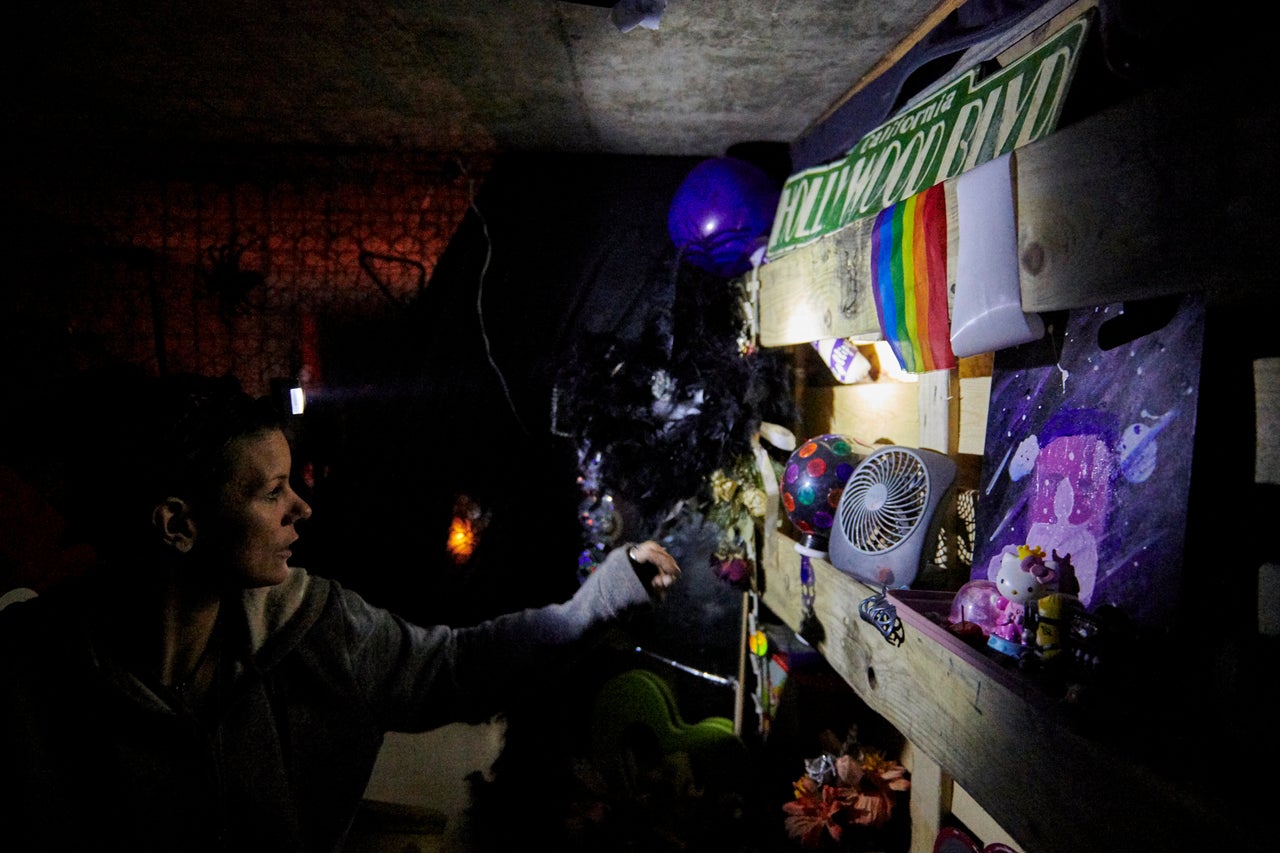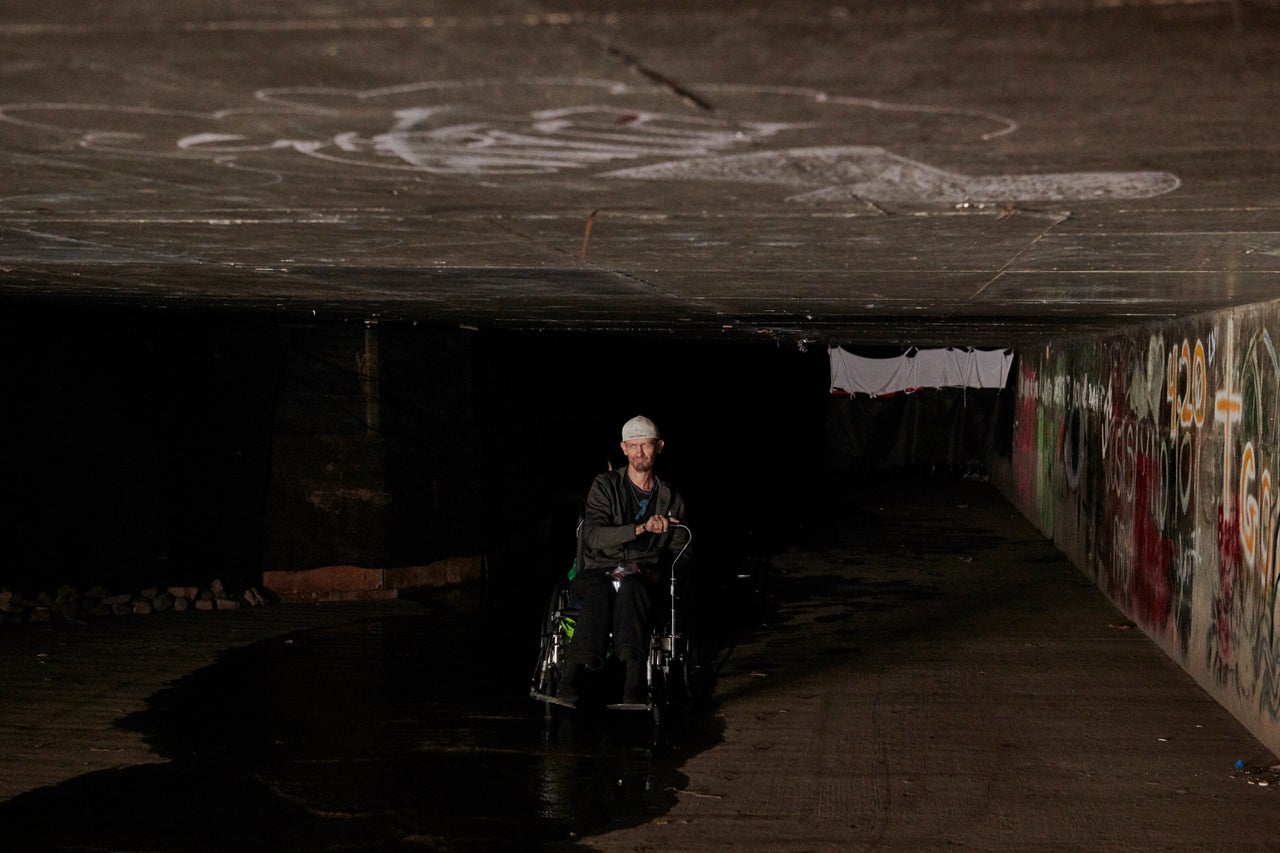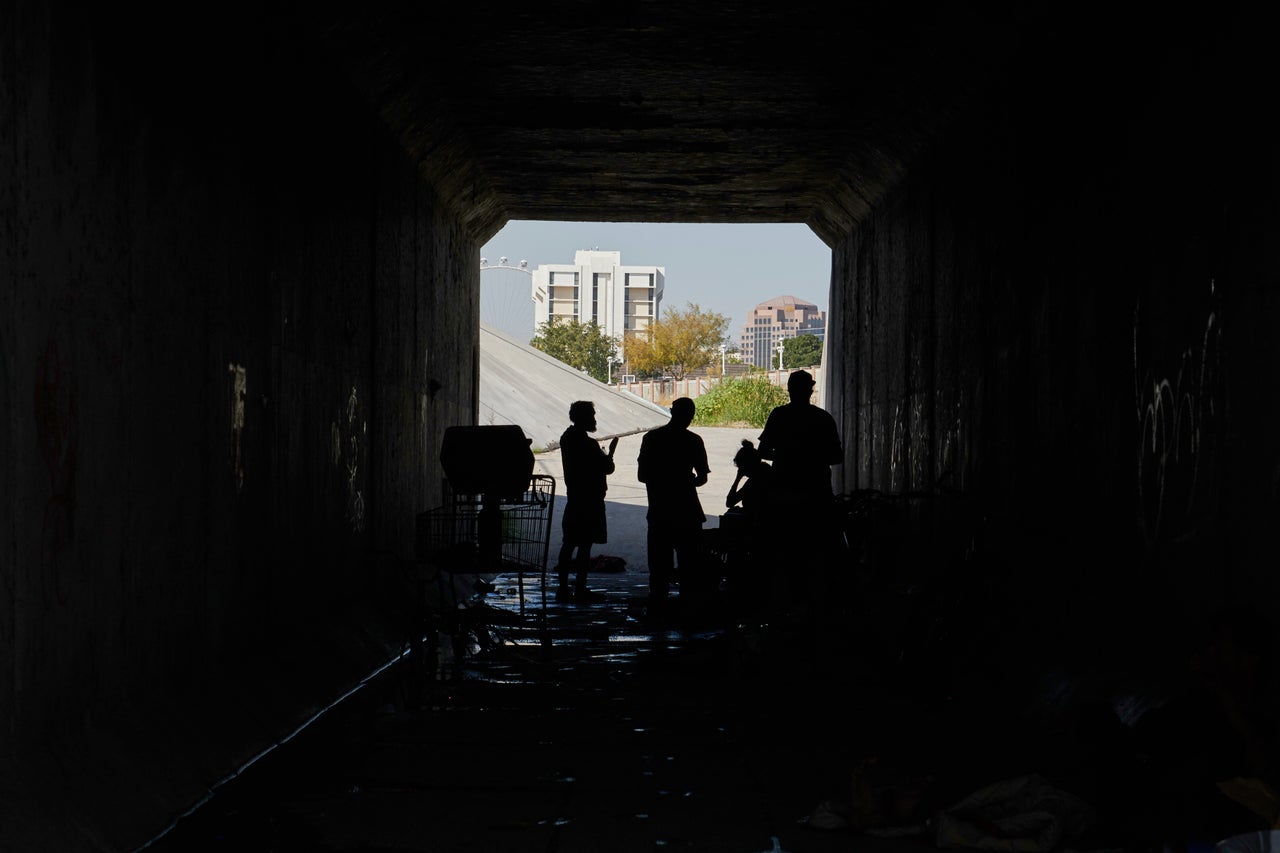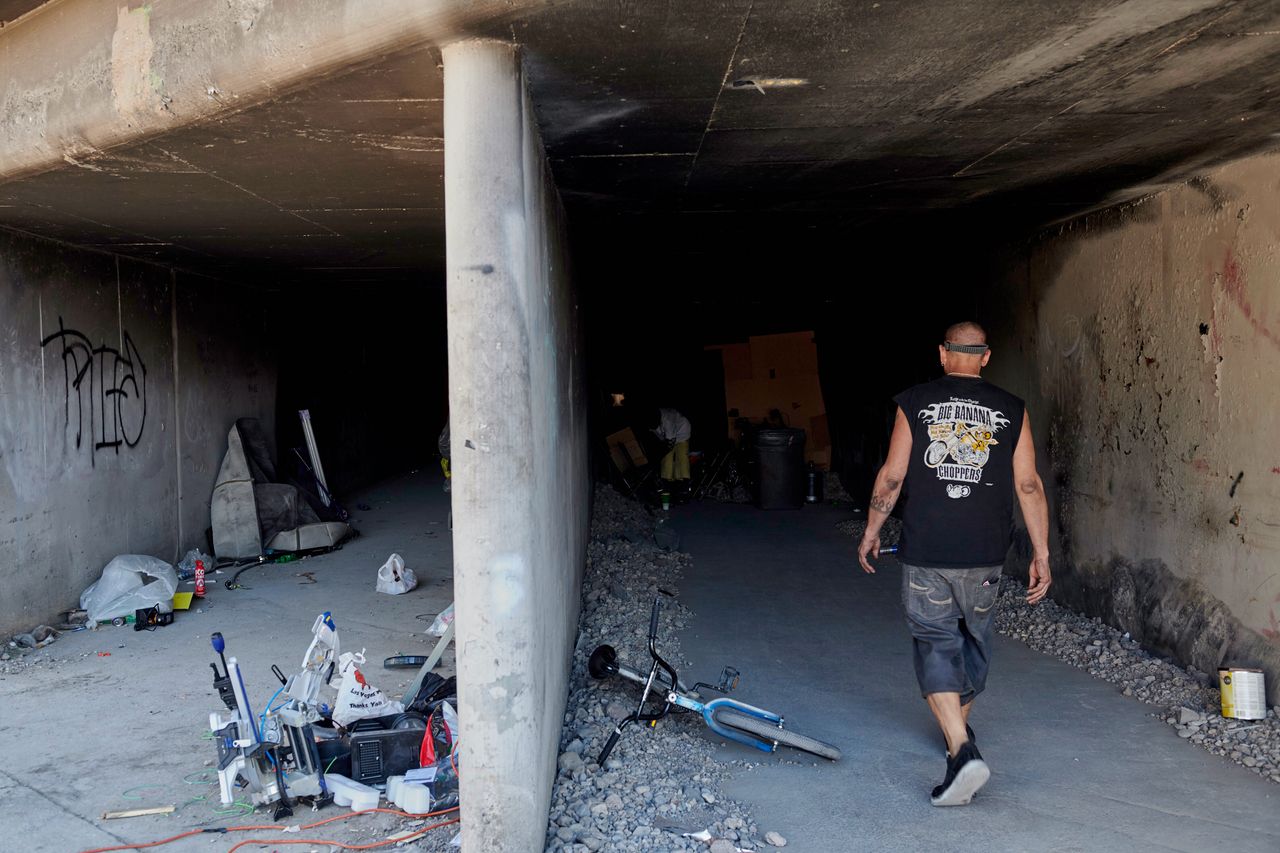LAS VEGAS – Donovan looked out on the swanky casino looming in the distance. Traffic whizzed along the nearby highway overpass. He stood, sockless in tennis shoes, at the mouth of the concrete tunnel where he lives, a five-minute walk from Caesars Palace hotel. Graffiti covered the tunnel walls that disappeared into darkness behind him.
After arriving in America’s gambling capital from California in 2013, Donovan had planned on working, but things didn’t turn out well. “It all went downhill, and here I am,” he said. Like others in this story, he agreed to be identified by first name only.
Donovan has been taking shelter in the concrete flood channels and tunnels that run directly under the Las Vegas Strip for the past two years. These dark passageways are part of a huge drainage network designed to protect the glittering casino district and its sprawling suburbs from flash flooding. And Donovan’s not alone down there. It’s estimated that nearly 300 homeless people live in these tunnels.
Although the figure represents just a fraction of the thousands living on the streets of Las Vegas, the tunnel dwellers are among the most difficult to reach for the social workers, who work below ground by flashlight to offer everything from clean socks and sandwiches to a chance at substance abuse treatment. Those living here choose to go underground for a variety of reasons, authorities say, but many suffer from substance abuse ― including heroin, crack and meth ― alcoholism and mental illness.
The conditions they endure are extreme. A heavy rainstorm can send millions of gallons of water rushing at up to 30 miles an hour through the concrete drainages. The last three flood-related drowning deaths in the city involved homeless people in the tunnels, said Erin Neff, spokesperson for the regional flood control district. “It’s tragic, to put it in one word.”

Flood district personnel, homeless advocates and emergency first responders try to encourage tunnel residents to vacate their camps during Las Vegas’ monsoon season, which runs from June to September. They don’t always succeed. Neff recalled the story told by one firefighter of a distraught homeless man who lost his grip on his partner and could only watch as the roaring torrent swept her away. Her body was recovered miles downstream.
The distressed man still chose to stay in the tunnels. “It’s the reality: Some of them just don’t want to come out of there,” Neff told HuffPost. “It’s heartbreaking.”
For Amanda – who’s battled drug addiction and has a criminal record – the tunnels provide a place to set up a home and set down roots of sorts, even if it will likely be flooded as soon as the monsoon comes.
By torchlight she showed us her bedroom, pushing open a plywood door and pointing proudly to her knick knack collection and the cutout roses tacked to the makeshift wall. The place is usually cleaner, she insisted, grabbing a broom and dusting off a rug spread on the concrete floor.
Amanda has lived underground for about a year, accessing her hidden home via a drainage canal near the Hard Rock Hotel and Casino. She was on the street before she moved into the tunnel. She and her partner, Robert, have worked hard to make this space feel like a home ever since. “It’s better [down] here,” said Amanda. “As weird as it sounds.”
Paul Vautrinot, a substance abuse caseworker, knows firsthand how difficult it is to get out of the tunnels and stay out. The 32 year old spent three years living underground and failed multiple times to get clean from his heroin addiction. After a warrant arrest for drugs in 2014, he went to rehab and got sober. He now helps operate Shine A Light, a small nonprofit that connects those living in the tunnels with safer housing and rehab programs. Vautrinot leads weekly outreach visits to the tunnel communities, handing out hygiene kits, bottled water, sandwiches, and socks to anyone who wants them.

HuffPost joined Vautrinot on one of these visits, arriving at a tunnel not far from a queue of 200 tourists waiting to take selfies at the iconic “Welcome to Fabulous Las Vegas” sign. There, Vautrinot met Big Craig, a soft-spoken Navy veteran who was reluctant to leave the tunnel, but put in a request for help to replace his broken-down size 13 shoes. The ground near Big Craig’s camp was littered with hypodermic needles. Vautrinot pulled out his phone and made a note to remember to bring shoes next time.
Many people in the tunnels are heavy drug users, Vautrinot said, and persuading them to accept free rehabilitation services and safer housing isn’t easy. On our trip with him, many declined to accept more than a sandwich. Some, however, agreed to take a black rubber wristband with Vautrinot’s personal cell phone number printed on it, as well as the number for his associate, Robert Banghart, a fellow recovering addict and former tunnel resident. Both men are employees of Freedom House Sober Living, an alcohol and substance abuse treatment program that also runs Shine A Light.
Despite the dangers down here, tunnel residents are often reluctant to return to life aboveground. Amid a shortage of homeless services, an increasingly severe affordable housing crisis in Las Vegas and hostile policies toward homeless people, leaving the subterranean camps poses its own risks.
Overwhelmed by need, government and social service nonprofits find themselves in an endless game of catch-up. Las Vegas has one of the worst rates of urban homelessness in the country. Roughly 5,500 people are homeless in the city. Yet only 2,000 shelter beds are available in the whole of Clark County, home to Las Vegas. “Our shelters are full or nearly full every night of the year,” said Emily Paulsen of the Nevada Homeless Alliance.
Even if there were enough spaces, it’s not enough to get a homeless person into a temporary shelter bed unless there’s also an affordable housing option for them at a later date, said Kevin Schiller, the assistant county manager in charge of family and social services. Las Vegas is the second least-affordable metro area in America, according to the National Low Income Housing Coalition, with only 14 affordable and available rental homes for every 100 of the city’s poorest renters.
Although the issues of homelessness and affordable housing are commonly analyzed separately, “they are all connected,” said Schiller.

Since the 2008 recession, real estate developers have focused more on building luxury rental units than on housing for low-income people, according to county commissioner Tick Segerblom. Clark County estimates that it needs 59,370 units to serve those already caught in the crunch. The county has embarked on an ambitious plan to incentivize affordable housing for developers with tax abatements and other breaks. So far, the county has funded just six affordable apartment complexes with a total of 503 units, but six more apartment complexes are planned, officials added.
Earlier this year, the county diverted a portion of the revenue from its legal marijuana industry to fund homeless services, including housing efforts. But Segerblom told HuffPost that “the marijuana funds aren’t enough” to meet the county’s needs. More investment is needed, he said.
While the city struggles to get a grip on its housing and homelessness crises, it has opted for policies that criminalize homeless people. In November, it passed a controversial ordinance making it a misdemeanor to camp or sleep on certain streets when there are shelter beds available. The measure, which will be enforced from February 2020, will affect residential areas and the downtown district, where most homeless services are located. People who violate the ordinance could face a $1,000 fine or up to six months in jail.
While the measure won’t directly impact people living in the tunnels, Paulsen said it’s likely to increase distrust between homeless people and organizations that try to connect them with services. “If someone is fearful that they are going to be arrested or ticketed, they are going to disengage from street outreach,” she told NBC News.

Until the city can meaningfully address some of its housing problems, Donovan, Amanda and Big Craig don’t see themselves leaving the tunnels anytime soon. The world that awaits them above still feels more frightening than the dangers they face below ground.
There’s no quick fix, Banghart says. Sometimes it takes dozens of visits to the tunnels to build a relationship.
“We show up every week,” he says. “We show them we care. We shake their hands and look them in the eyes and let them know there is an option. We offer them hope. A lot of the time it takes showing up week in and week out and letting them know we care. There is a way out. We are there when they are ready.”
If it matters to you, it matters to us. Support HuffPost’s journalism here. For more content and to be part of the “This New World” community, follow our Facebook page.
HuffPost’s “This New World” series is funded by Partners for a New Economy and the Kendeda Fund. All content is editorially independent, with no influence or input from the foundations. If you have an idea or tip for the editorial series, send an email to thisnewworld@huffpost.com.
